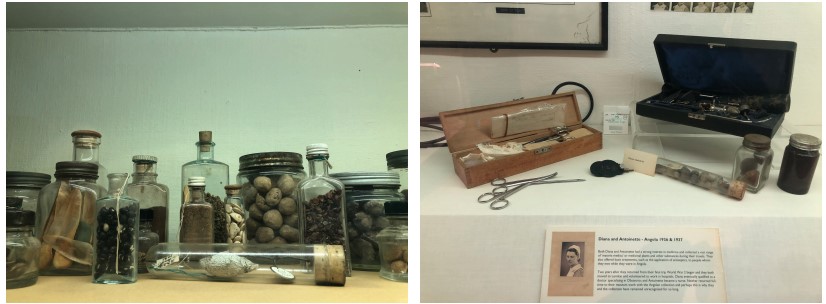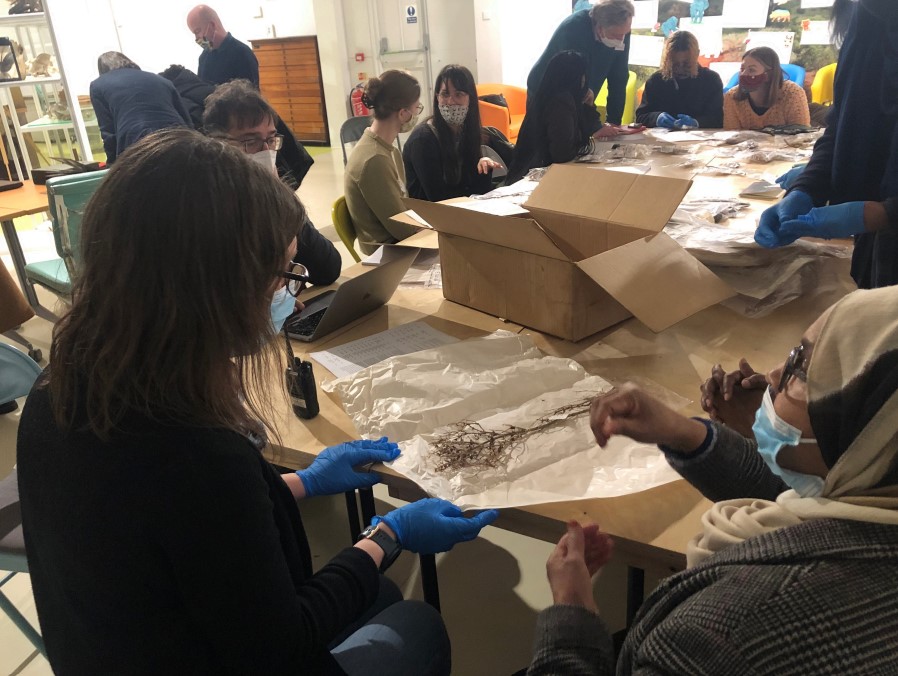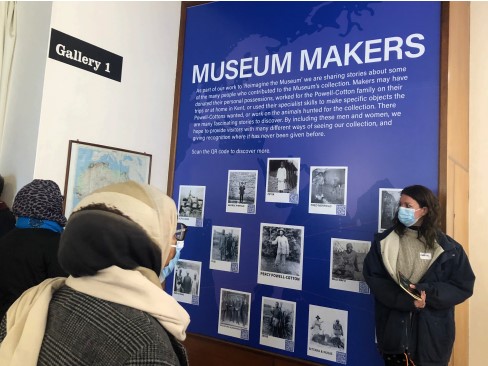March 11th 2022, Powell-Cotton Museum
Written by Alexandra Slucky (Assistant Heritage Consultant & Environmental Archaeologist, Atkins, York Office) and Fiona Roberts (Collaborative ESRC PhD student, Cardiff University & Amgueddfa Cymru-National Museum Wales).
Decolonizing collections has been at the forefront of museums for quite some time. Thinking beyond the Western museum structure, many institutions have taken new opportunities to view indigenous knowledge from indigenous perspectives by revisiting old collections of anthropological material intermixed with botanical specimens. Four years in the making, Workshop One is part of a one-year project called ‘People and Plants: reactivating ethnobotanical collections as material archives of indigenous ecological knowledge‘, beginning in January 2022. It is led by National Museums Scotland, Royal Botanic Gardens, Kew, and the Powell-Cotton Museum, and funded by the Arts and Humanities Research Council (AHRC).
The main aim of the project is to engage with three unique indigenous collections located in UK institutions; Somalian, Amazonian, and Aboriginal Australian. The project examines the value and relevance of ethnobotanical collections, both in the present and the future, aiming to bring academics, researchers, museum professionals, botanists and indigenous knowledge holders together in conversation. To focus on sharing authority, it gives a museum voice to women of colour through a process of reactivation, recovery, and relationships, with the result creating more inclusive conditions for future collections.
Following an introduction to the project and workshop aims, the Head of Collections at the Powell-Cotton, Inbal Livne, gave a fascinating tour of the museum. We learnt about the founder of the museum, the hunter and explorer Percy Powell-Cotton, and his daughters Antoinette and Diana. Wandering through nine different galleries, we heard stories about the extensive array of natural history and ethnographic objects they collected, from mounted big game heads from Africa and Asia to ethnographic footage shot by the daughters.

Taxidermy was displayed in large natural history dioramas, sparking conversations about its curation, with Inbal telling us about a staged taxidermy fight between a lion and buffalo, containing the actual lion specimen that had almost killed Powell-Cotton. While described as something that he fought off, in reality, he was saved by indigenous staff, something excluded from the original curatorial narrative. Inbal explained how interpretation was changing to focus on the diversity of voices and stories from communities they were collected from.
Workshop Presentations
We then had presentations by female scholars on the value of revising indigenous ethnobotanical collections found within UK institutions. March’s workshop focused on Somalia, and was headlined by Abira Hussein, PhD candidate at UCL School of Information Studies. She created the NOMAD project which uses immersive mixed reality technology to engage Somali communities and provide context to heritage objects. She explained how archives and museums can be broadened to include memories and experiences, by adding embodied, lived knowledge. Her multisensory workshops delivered sound and video via headsets or postcards with QR codes, and 3D printing replicating tactile knowledge. Following this, we heard from Rosa Dyer, a PhD candidate at the Pitt Rivers Museum and Birkbeck, University of London. Her work with the museum’s Somali Diana Powell-Cotton collection investigated ethnobotanical specimens from 145 different plants and 13 Somali communities. Rosa considered if Diana was better able to access knowledge about female medicinal uses as a woman, and noted how local rather than scientific names were used, and plants that could be combined into specific medicinal treatments.

Finally, the Powell-Cotton’s Head of Collections, Inbal Livne, discussed decolonising museum catalogues and community engagement. Each institution has a unique relationship with its collections, and reciprocal connections between the museum, community and academic expertise allow them to be cared for most successfully. When re-examining cataloguing systems, Inbal suggested starting with collections that don’t fit neatly into existing categories, letting organic processes emerge and following where this leads. This could involve bringing plants out of the museum, and instead having conversations in nurturing, living-room-style environments.
To watch the workshop talks, visit: People and Plants – YouTube.
Valuable Insights through Object-Based Engagement
We then looked at object-based engagement with the Somali Diana Powell-Cotton collection. We handled items and examined them together, sharing our impressions of how this knowledge could be represented, and possible issues like if communities were correctly named. Many organic discussions emerged from this unique hands-on experience between all the participants of the workshop allowing for a more holistic collections engagement. At the end of the day, group discussion reflected on these conversations and the feelings invoked from the object engagement and sharing of knowledge.
The first of three workshops, the experience was enriching to all and demonstrated the power of knowledge sharing with ethnobotanical collections, especially those with historically colonial roots. It helped us all consider: If we want to understand the value of collections, we need to think about the value of where they are discussed.

Future work
To continue the discussions brought about by the first of three People and Plants workshops, future events focus on collections from Brazil (at Royal Botanic Gardens, Kew) and Australia (National Museums Scotland). To stay connected with the project, visit: http://www.natsca.org/people-and-plants.
Participants of workshop included: Hanna Adan (BBC), Ali Clark (NMS), Rosa Dyer (Pitt-Rivers), Ayesha Fuentes (MAA), Jonn Gale (Independent), Shahina Ghazanfar (Kew), Isla Gladstone (Bristol Museum), Abira Hussein (UCL/NOMAD), Naima Hussein, Fardous Kalinle (NOMAD), Inbal Livne (Powell-Cotton), Luciana Martins (Birkbeck), Mark Nesbitt (Kew), Raj Puri (Kent), Fiona Roberts (Cardiff), Alexandra Slucky (UCL Institute of Archaeology), Zahra Suleiman (NOMAD), Shamso Wardere (NOMAD), Johanna Zetterstrom-Sharp (Horniman).



Pingback: NatSCA Digital Digest – July 2022 | NatSCA
Pingback: Listening and learning: Reflections on the Second Workshop of the People and Plants Project | NatSCA
Pingback: Top NatSCA Blogs of 2022 | NatSCA